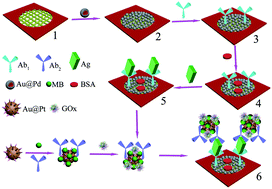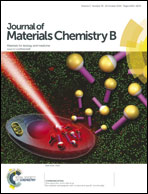A 3D origami electrochemical immunodevice based on a Au@Pd alloy nanoparticle-paper electrode for the detection of carcinoembryonic antigen†
Abstract
Herein, a novel 3D microfluidic paper-based electrochemical (EC) immunodevice (μ-PEI) for sensitive detection of carcinoembryonic antigen (CEA) was developed. Au@Pt core–shell nanoparticles (NPs), with high conductivity, large surface area, and synergistic electronic effects, were not only used as carriers of secondary antibodies, methylene blue (MB) redox probes and glucose oxidase but also catalyzed the EC reaction of MB, thus amplifying the EC signal of MB in the presence of glucose. In addition, using a novel Au@Pd alloy NP modified porous paper working electrode as the biosensor platform could not only enhance the surface area to immobilize antibodies but also catalyze the reduction of hydrogen peroxide, which further amplified the detection response. On the basis of the considerably amplified EC signal and the sandwich-type format, the EC immunosensor has a sensitive response to CEA in a linear range of 1.0 pg mL−1–100 ng mL−1 with a detection limit of 0.4 pg mL−1. Additionally, this 3D μ-PEI showed satisfactory reproducibility, selectivity and stability.



 Please wait while we load your content...
Please wait while we load your content...